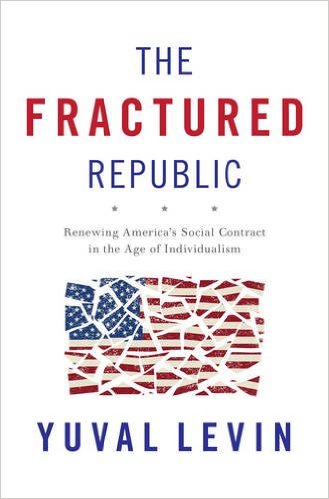The Conservative Way Forward?
By Arnold Kling

Our highly individualist, liberationist ideal of liberty is possible only because we presuppose the existence of a human being and citizen capable of handling a remarkably high degree of freedom and responsibility. We do not often enough reflect on how extraordinary it is that our society actually contains such people. A population of citizens generally capable of using their freedom well is the greatest achievement of modern civilization—greater even than the US Constitution and the market system, which depend upon such people.
—Yuval Levin, The Fractured Republic: Renewing America’s Social Contract in the Age of Individualism, page 202.
In his important new book (forthcoming, May 24, 2016 from Basic Books),1 Yuval Levin offers a diagnosis of America’s illness and a prescription for a cure. His diagnosis blames both the left and the right for promulgating an untenable vision of an individualistic society under the umbrella of the central government. The result has been to demean and weaken mid-level social institutions, including local government, organized religion, and the charitable sector. He argues that such institutions are the best hope for addressing challenges that require collective action but for which the federal government is poorly equipped.
The problems we expect government to handle are themselves highly complex, and internalizing complexity in a centralized bureaucracy does not make it go away; it merely assigns it to an institution likely to be uniquely ill-suited to handling it.
We would do better to assign such complex challenges to a widely dispersed network of local, on-the-ground problem-solvers who, given the right kinds of rules and incentives, will be more likely to possess the needed knowledge and the capacity to seek out solutions in a flexible way. (page 137)
“Each side is nostalgic for a golden age which is not going to be restored, if it ever existed in the first place.”
Levin believes that both progressives and libertarian conservatives suffer from a naive view of history. Each side is nostalgic for a golden age which is not going to be restored, if it ever existed in the first place.
For Levin, it is important to understand the twentieth century in terms of an arc of consolidation and diffusion. The trend toward consolidation culminated in the era after the Second World War which Levin calls the Age of Conformity. The subsequent diffusion produced what he calls the Age of Frenzy.
In the decades leading up to the mid-1960s, the United States underwent consolidation. The economy came to be dominated by giant manufacturing firms and labor unions. Our culture was becoming more homogeneous, under the sway of mass media. The Democratic and Republican parties were tightly controlled by their core leaders, and the parties were sufficiently similar that policies could be adopted with bipartisan consensus.
Both the right and the left are nostalgic for elements of the Age of Conformity.
Liberals are especially nostalgic for the economic and political order of that era. Government was growing, the labor movement was powerful, and large corporations in key sectors seemed content to work with government and labor to manage the affairs of the nation. This combination seemed to deliver broadly shared prosperity for a generation. Meanwhile, a surge in confidence in government led to the Great Society agenda and to a managerial politics that offered a public program to cure every public problem. (page 19)
Conservatives miss the cultural environment of the Age of Conformity. Strong families produced a baby boom. Movies and television were much tamer than they are today. Government and religious institutions enjoyed a much higher level of trust.
By the end of the Age of Conformity, the forces of consolidation were being replaced by forces of diffusion. Large corporations lost their grip on the economy, as Europe and Japan recovered from the Second World War and began to compete effectively. The personal computer revolution and the Internet accelerated this change.
The Keynesian system for regulating the economy broke down in the 1970s. The ensuing malaise forced policy makers to back away from the corporatist model of economic governance.
Thus, in the mid- and late 1970s, a wave of deregulation began to roll through the economy. It represented the unraveling of the prewar economic order that still defined much of the US economy, restraining competition and imposing uniformity… The government loosened and in places reversed its tight control of the infrastructure of the economy. Barriers to entry were removed, and competition was increasingly encouraged and rewarded. (page 63)
Conservatives also applauded many of the economic policy changes. Even though much of the deregulation began under President Carter, conservatives associate the economic growth that followed with the Reagan era.
While conservatives may have been pleased with the economic dynamism of the Age of Frenzy, they are much less happy with the cultural changes that took place. The traditional family steadily gave way to reduced marriage rates, increased divorced rates, and out-of-wedlock births. The tame, homogeneous media culture gave way to a diversity of entertainment sources serving a variety of tastes, including coarse ones.
See also the EconTalk podcast interviews Yuval Levin on Burke, Paine, and the Great Debate, May 2014 and Kling on the Three Languages of Politics, June 2013.
Levin says that we are now in the Age of Anxiety. He believes that the challenges we face today cannot be solved by trying to return to an earlier era. We are not going to revert to a simpler economy that can be managed through cooperation among labor leaders, corporate executives, and federal government officials. We are not going to revert to a tame, homogeneous natural culture. The nostalgia of both the right and the left for longed-for elements of the Age of Conformity is not constructive. The toothpaste is not going back into that tube.
Levin also argues that we have reached the limits of the benefits of the trend toward individualism that took off at the end of the 1960s. Indeed, he would say that in many ways we have gone beyond those limits, and that further change in that direction will mostly have costs. Thus, he would reject the right’s nostalgia for a revival of the Reagan era, and he would not share the views of those libertarians who see paradise in terms of the removal of governmental and social restraints.
Levin rejects the binary choice between strong central government and pure individualism. Instead, he extols what he calls the mediating institutions of families, local government, religious institutions, and charity. His idea of paradise would be a nation in which these institutions are allowed to experiment with a variety of ways of trying to help nurture and educate citizens who are capable of exercising freedom.
If Levin is right, then it would help to have the federal government back away from many of the responsibilities it has taken on over the past fifty years. Instead, more authority and responsibility should be left to these mediating institutions.
For me, Levin offers an appealing vision. However, I wonder if it can ever attract broad public support. In 2016, it appears to me that Americans do not value freedom as much as they used to. If President Obama represented the nostalgia for the era of Lyndon Johnson’s Great Society, then currently his party seems to be moving even further to the left, with many believing that some form of socialism is the answer. On the Republican side, it seems ironic that the candidate who gained ascendancy by promising to wall off our southern neighbors would appear to wish to run the United States like a Latin American strongman. And on college campuses, many students and administrators prefer “safe spaces” to free speech.
I worry that mediating institutions have lost their effectiveness. The broad middle class has given way to a bifurcated society, with the highly-educated and the less-educated no longer attending the same churches or sharing similar life experiences. The close-knit neighborhood has given way to the anonymous city, where local government is mostly responsive to powerful public sector unions and favor-seeking businesses. Perhaps this means that Levin’s vision is nearly as unrealistic as those that he criticizes. Restoring our mediating institutions might be yet another exercise in trying to squeeze the toothpaste back into the tube.
For more articles by Arnold Kling, see the Archive.

